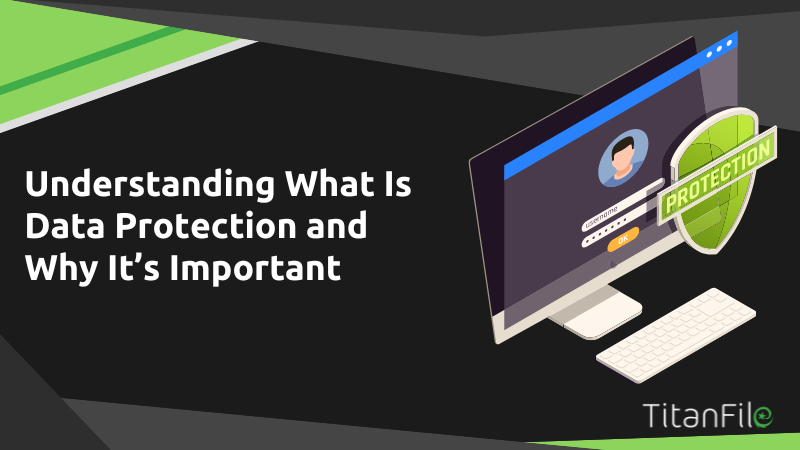“What is data protection and why is it important?” is a question that many people ask.
Data protection is the strategic defense against unauthorized use, corruption, or theft of digital information. It’s crucial because it shields both individuals and organizations from the potentially catastrophic consequences of data breaches, such as financial loss, privacy violations, and compromised reputations.
By grasping what data protection is and why it’s important, we lay the groundwork for understanding how to effectively shield our sensitive information in an increasingly data-driven world. This article delves into the core principles of data protection, including availability, integrity, confidentiality, and sheds light on the urgency of robust data security measures.
INSIDE THIS ARTICLE
Key Takeaways
- Data protection is critical for maintaining the integrity, availability, and confidentiality of sensitive information, akin to safeguarding jewels in a secure vault.
- Effective data security measures such as access controls, encryption, and regular security audits are vital to protect data from unauthorized access, ensuring compliance and identifying vulnerabilities.
- Compliance with data protection laws—like the HIPAA, PIPEDA, and GDPR—is mandatory for organizations to avoid substantial fines and legal repercussions, and the adoption of emerging technologies such as cloud solutions, AI, and the Zero Trust security model enhances data safety.
The Fundamentals of Data Protection

Imagine a vault filled with precious jewels. Data protection is akin to the robust security measures that safeguard those treasures. It’s about preserving the integrity, availability, and confidentiality of sensitive information, just as a vault protects diamonds from theft. As the volume of data we generate and store continues to grow exponentially, the stakes are becoming higher with a low tolerance for downtime.
The need to thwart unauthorized access and guarantee quick recovery post-incident is paramount.
Data Availability
Like a well-oiled machine, businesses need to operate smoothly and without interruption. Ensuring data availability is akin to maintaining seamless machinery operations, mitigating the risks of operational disruptions and potential revenue loss. The objective is to guarantee that users can access required data, even under circumstances where the original data gets compromised or becomes inaccessible. Implementing data lifecycle management and effective data management can be crucial steps in achieving this goal.
After all, what good is a vault if you can’t access the jewels inside when you need them?
Data Integrity
Data integrity is the assurance that our precious gems remain untarnished. The goal is to confirm the precision and reliability of input data. Regular removal of duplicate data and the implementation of strict access controls help maintain data integrity.
After all, unreliable or inaccurate data is like a counterfeit diamond — worthless for making informed decisions.
Data Confidentiality
Data confidentiality thwarts unwarranted access to our treasure vault. To protect data, ensuring sensitive data is safe from breaches that may trigger fraud, identity theft, and legal repercussions is vital, as it directly impacts customer faith and loyalty. Protecting data should be a top priority for any organization.
Proper data storage, secure access management, and stringent control over data access points are essential to uphold data confidentiality. Implementing copy data management can help in achieving these goals. Because once the jewels are stolen, it’s too late to lock the vault.
The Role of Data Security in Data Protection

Data security is the guardianship of our vault. It employs technologies such as access controls, encryption, and regular security audits to protect our treasures. It involves practices like multi-factor authentication and end-to-end encryption to prevent unauthorized access.
The aim is to comprehend what is stored in the vault, its processing, and storage methods to establish robust security controls. Because even the most secure vault is useless without skilled and vigilant guardians.
Access Controls
Consider access controls as the keys to our vault. They restrict who can get in and what they can do once inside. Discretionary Access Control (DAC) and Mandatory Access Control (MAC) are two methods used to manage these keys.
While DAC allows data owners to define permissions, MAC provides access on a need-to-know basis. The task is to guarantee that only authorized individuals have the precise keys to access relevant resources.
Encryption
Encryption is like an unbreakable code that protects our treasure. It converts data into a code that can only be read by authorized parties, playing a critical role in securing data storage and protecting against unauthorized access. It involves using techniques like symmetric encryption, which uses a single key, and asymmetric encryption, which uses a public key for encryption and a private key for decryption.
It’s akin to communicating in a secret language comprehensible only to you and your trusted circle.
Regular Security Audits
Regular security audits are like routine inspections of our vault. They:
-
- Identify vulnerabilities and weaknesses in IT systems
- Bolster data protection strategies
- Ensure compliance
- Review how sensitive data is stored, transmitted, and disposed of
- Review how access controls are implemented
These audits are essential for maintaining the security of your systems and protecting your data.
It resembles a periodic health check-up to confirm the optimal condition of our vault and its security apparatus.
The Impact of Data Breaches on Data Protection

Data breaches are like a successful heist on our vault. They can result in significant financial losses, reputational damage, and legal liabilities, emphasizing the importance of data protection. These breaches pose a risk to national security and potentially expose proprietary data to competitors. It’s a stark reminder that no vault is impregnable and that we must always strive to improve our security measures.
Financial Losses
The financial impact of a data breach can be devastating. The global average cost of a data breach in 2023 was $4.45 million, a 15% increase from 2020. For large-scale breaches involving 50 million records or more, companies face costs that can exceed $300 million.
This is comparable to a leaking vault, with precious gems slipping away, significantly impacting the financial statement.
Reputational Damage
Reputational damage following a data breach can erode trust among consumers and stakeholders, potentially leading to a loss of business and long-term harm. This is similar to a once-reliable vault losing its reputation, leading customers to reconsider depositing their valuables.
Legal Liability
Data breaches can lead to significant legal liabilities, including hefty fines and legal costs. It’s like a violation of the trust placed in us as the guardians of the vault, leading to legal consequences.
Key Data Protection Laws and Regulations

Data protection laws and regulations act as the norms and guidelines for ensuring the security of our vault. They include:
- The Health Insurance Portability and Accountability Act (HIPAA)
- The Personal Information Protection and Electronic Documents Act (PIPEDA)
- The General Data Protection Regulation (GDPR)
Each law has its own set of requirements and penalties for non-compliance.
HIPAA
The Health Insurance Portability and Accountability Act (HIPAA) is like the healthcare law for data protection. It focuses on protecting sensitive health information, including personally identifiable information, and ensuring the privacy of patients’ medical records.
Failing to comply with HIPAA can result in severe fines and legal consequences.
PIPEDA
The Personal Information Protection and Electronic Documents Act (PIPEDA) regulates how private-sector organizations collect, use, and disclose personal information in for-profit or commercial activities in Canada.
Organizations can be fined up to $100,000 CAD per violation for knowingly violating PIPEDA requirements and failing to report data breaches.
GDPR
The General Data Protection Regulation (GDPR) is like the constitution for data protection in the European Union. It sets stringent requirements for personal data collection, processing, and storage.
Violating the GDPR can expose organizations to substantial fines of up to €20 million or 4% of their total annual turnover, whichever is greater.
Implementing Effective Data Protection Strategies

Implementing effective data protection strategies is like establishing a sophisticated security system for our vault. It involves comprehensive risk assessment, rigorous employee training, and meticulous incident response planning.
Risk Assessment
Risk assessment resembles a proactive scrutiny of our vault. It identifies potential threats and vulnerabilities, thereby preserving data privacy and aiding in informed decisions to reduce or eliminate risks. It enhances risk mitigation strategies, increases consumer trust, and ensures compliance with laws such as GDPR.
Employee Training
Employee training equips our vault guardians with the necessary knowledge and expertise to safeguard the treasures inside. It’s crucial to maintain data confidentiality and lower the possibility of data breaches.
Cybersecurity training should emphasize the importance of individual responsibility and simulate real-life cyber threats for educating employees.
Incident Response Planning
Incident response planning is akin to formulating a contingency plan for our vault. It outlines the steps and actions to be taken during a breach event. Regular testing of the plan against different scenarios ensures preparedness for various breach situations.
Organizations with robust incident response frameworks can save millions during a data breach.
Emerging Trends in Data Protection
Emerging trends in data protection solutions act as the newest security enhancements for our vault. These include:
-
- The adoption of cloud-based solutions
- The use of AI and machine learning technologies for advanced threat detection
- The implementation of the Zero Trust security model
Cloud-Based Solutions like TitanFile
Cloud-based solutions such as offer the following benefits:
-
- Unlimited space
- Superior security features
- Scalability
- Enhanced resilience
- Data portability
- Encryption technologies to maintain data security
Artificial Intelligence and Machine Learning
Artificial Intelligence and Machine Learning function as the sophisticated security systems of our vault. They can detect suspicious activity by analyzing data to identify threats, trends, and patterns of cybercrime attacks.
They also enable adaptive security measures that continuously evolve by learning from new data.
Zero Trust Security Model
The Zero Trust security model embodies the guiding principle behind our vault’s security. It operates on the notion that no inherent trust is granted to users or devices, irrespective of their location inside or outside the network. It enforces stringent controls and minimizes unauthorized access, thus shrinking the attack surface and mitigating the likelihood of data breaches.
Summary
In conclusion, data protection is not just about securing our “vault” of data, but also about ensuring its integrity, availability, and confidentiality. It involves employing effective data protection strategies, complying with data protection laws, and adapting to emerging trends in data protection. As we continue to navigate the digital age, let us remember that data protection is not a one-time event, but a continuous process that requires vigilance, adaptability, and commitment.
Frequently Asked Questions
Why is data protection is so important?
Data protection is crucial as it prevents fraud and cybercrimes by safeguarding personal and organizational data, thereby avoiding reputation damage and confidential information leaks.
What is data protection in simple words?
Data protection is the process of safeguarding important data from loss or corruption, ensuring the ability to restore it if needed. It encompasses backup and recovery, security against manipulation and malware, and control over data access.
What is the main aim of data protection?
The main aim of data protection is to safeguard important data from corruption, compromise, or loss, and to restore the data to a functional state if it becomes inaccessible or unusable.
What are some of the consequences of a data breach?
Data breaches can lead to significant financial losses, reputational damage, and legal liabilities, eroding customer trust and loyalty in the process. It’s crucial to prioritize robust data security measures to mitigate these risks.
What are some key data protection laws and regulations?
Key data protection laws and regulations include the General Data Protection Regulation (GDPR), California Consumer Privacy Act (CCPA), and Health Insurance Portability and Accountability Act (HIPAA), among others. Stay informed and comply with these regulations to protect personal and sensitive data.

